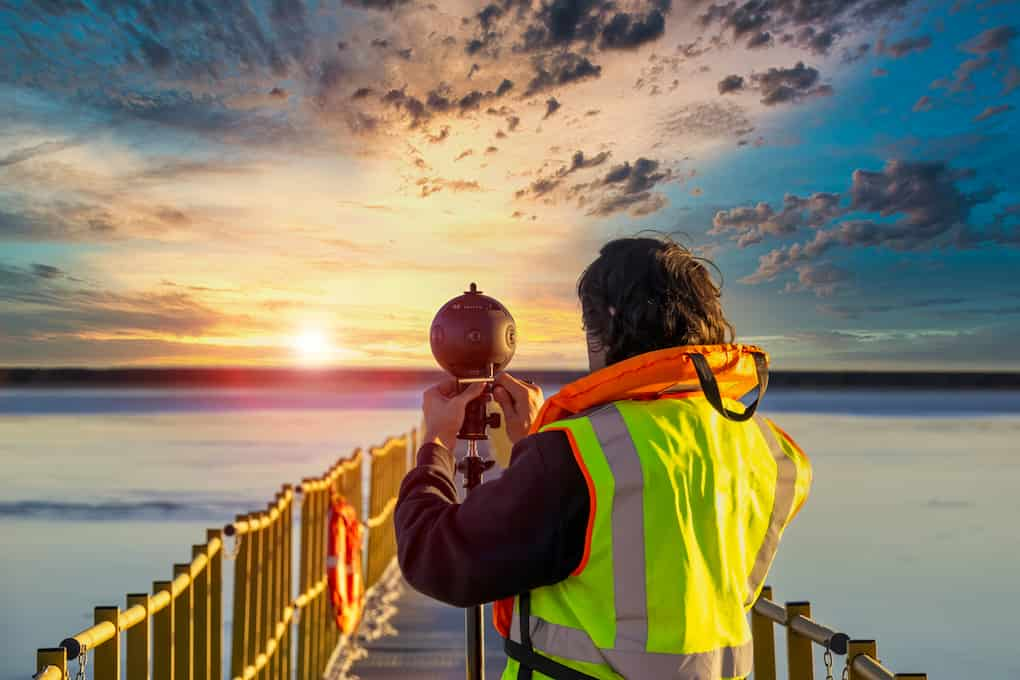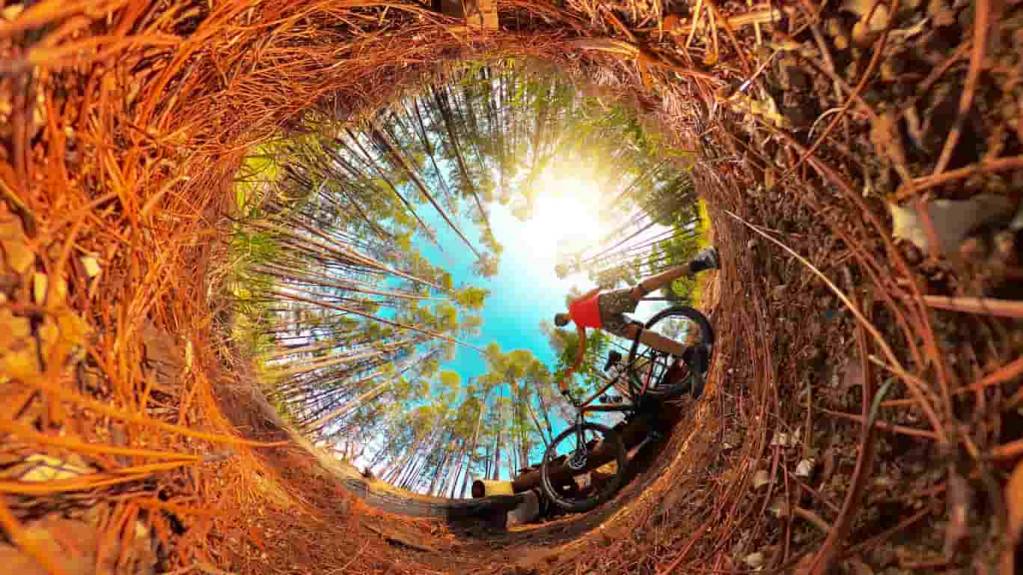The Definitive Guide to VR Video Streaming and 360° Video
Virtual reality (VR) video streaming is trending in the online video space. This innovative twist on video is helping organizations connect with their audience in a way that is more lifelike and engaging than regular video content.
Virtual reality and 360 video streaming are developing surprisingly fast after being thought of as “futuristic” for many years. These technologies have been gestating for decades, but only now is computing power and bandwidth catching up to make them a reality. The VR renaissance is here at last.
In this article, we’re going to examine the connections between live video streaming and the virtual reality revolution. We’ll introduce the technology and go over its history before we explain some technical differences between VR video streaming and 360 video streaming.
From there, we’ll take a look at VR live streaming and discuss what that could mean for professional broadcasters. To wrap things up, we’ll share a VR workflow and discuss challenges with this technology.
Table of Contents
- The History of Virtual Reality
- Virtual Reality and 360 Video: What’s the Difference?
- Uses for VR Video Streaming
- 360 Live Streaming: The Next Frontier
- The Typical VR Streaming Workflow: A Walkthrough
- Challenges in 360 and VR Video Streaming
- Conclusion
The History of Virtual Reality


The idea of virtual reality is simple: create a synthetic environment that people can enter at will. VR video streaming is all about an immersive streaming experience that attempts to mimic reality.
The concept of VR has been around for a long time. The history of VR goes back to the 1930s when science fiction author Stanley G. Weinbaum first came up with the concept. Over the next 70 years, VR technology advanced very slowly. The first VR machines weren’t digital at all. Instead, they were large boxes you stuck your head into that used mechanical means to change artwork around you.
Between the 1980s-2000s, VR became more common in niche applications. Sega and Nintendo developed some of the first video game VR systems. Military and aviation industries spent large sums to develop VR flight and combat simulators for training pilots and fighters. NASA developed a similar platform to pilot the Mars rovers. Medical firms developed several training platforms for surgery simulations.
It wasn’t until the past decade that VR really took off. In 2010, the first prototype of the Oculus Rift was released. The Oculus VR corporation was subsequently purchased by Facebook in 2014 for $2 billion. It took until March 2016 before a product version of Oculus Rift hit the market. The platform features an OLED display at 1080×1200 pixel resolution per eye and a 90 Hz refresh rate.
The first consumer-grade VR operating system was released in 2016. The VIVE SteamVR became available for around $1000. The setup was bully since it required several towers to operate. That same year, the NFL partnered with YouTube and Google to create a 9-art series filmed in 360 VR. The NBA is now broadcasting several full games per year in 360 virtual reality.
In 2020, Oculus released another consumer-grade VR headset, called Quest 2, that absolutely changed the game. This headset’s quality is far more superior to other consumer-grade VR consoles and it is available for $299.
The accessibility of the Quest 2 makes it possible for more consumers to access VR video streaming. It also makes it easier for smaller businesses to use VR technology for marketing, sales, product demos, live streaming events, and other functions.
At this time, we’re still at the forefront of VR’s developments. This technology is likely far from its final form as it is still developing and evolving.
Virtual Reality and 360 Video: What’s the Difference?


The terms “360 video” and “virtual reality” are often thrown around interchangeably to describe immersive streaming. Technically, there is a big difference between virtual reality and 360 video. Virtual reality, in full implementation, allows users to move around in an artificially generated environment. You can interact with objects, walk, run, climb, and otherwise function as you would in the real world.
Modern VR implementations have limitations that don’t allow them to reach this ideal. The best most VR games can do is allow you to use a video-game controller to actually move around in the virtual world. You can swivel and turn in place as much as you want, but the advanced movement isn’t possible yet.
Most of what passes for VR these days is actually 360 video. This simply means a video that’s been recorded in every direction at once. This allows users wearing a headset to “look” around. For users inside a circular arrangement of monitors, they can simply turn around.
However, in 360 videos, you can’t change the position of the cameras. That’s determined by the person who made the recording. That’s the difference between true VR and 360 video. Some professionals describe 360 video as the “bridge” content—standard flat video stretched across a circular frame.
Uses for VR Video Streaming
There are many potential use cases for VR video streaming. Its most popular use case is still entertainment, but it can be used for sales, marketing, training, and other business functions.
During COVID-19 lockdowns, 360 video and VR video streaming was used for potential homebuyers to “tour” homes that they were interested in. This helped minimize contact with sellers and realtors.
VR has also been used for test driving vehicles which have allowed buyers to reimagine the car buying experience.
The fashion industry is also toying with the idea of using VR to allow shoppers to try on clothing when they are shopping online.
360 Live Streaming: The Next Frontier
In the world of video, development happened in stages. First, there were video recordings, then television broadcasts, and then online video and live streaming.
VR and 360 video are following a similar path. Although VR video is still a niche technology, live streaming is already possible. The Verge calls live VR video “the gateway drug between what most people watch today and the immersive era of virtual reality that is just getting underway.”
Live streaming is more challenging than on-demand video streaming because it requires the infrastructure to deliver content almost as quickly as it is captured. Technically speaking, most VR live streaming is really 360 live streaming video at this time.
Unfortunately, most viewers and content creators aren’t prepared to create or watch this type of content yet due to the unique design and size of the video files. People need better tools and more bandwidth than is typically available.
We suspect that these obstacles will soon be a thing of the past. Internet speeds are increasing, computer power is rising, and compression algorithms are getting more effective. These factors, combined with the fact that VR streaming will be a truly powerful communication medium, make the transition inevitable.
While it is still fairly uncommon, there are some software offerings available that support 360 live streaming, such as Wowza’s Live 360 Degree streaming tool.
The Typical VR Streaming Workflow: A Walkthrough


VR video streaming requires a very specific streaming setup that uses special techniques. There are a few differences when compared with a traditional broadcast setup.
Let’s look at the different parts of a VR and 360 video streaming workflow.
1. Rig and Studio
First up is the camera itself. Here’s the thing: you need more than one.
In the past, 360 video recording was extremely expensive, requiring custom-built rigs of multiple cameras linked to a single controller.
However, that’s changed over the last few years. Modern cameras that allow 360 recordings are surprisingly affordable. In fact, you can get your hands on one for just a couple hundred dollars. Broadcast-quality 360 cameras that will capture ultra-high resolutions can be purchased for four or five thousand dollars.
Audio is another important part of VR video. A gorgeous 360 recording can be completely ruined if the audio sounds off.
In real life, turning your head changes the orientation of your ears and alters how things sound. For this reason, VR and 360 videos have to be paired with specialized, stereo sound recording for maximum impact. That means omnidirectional microphones and careful mixing to ensure the right sounds are reaching the viewer at the right time.
All this will require support from tripods and mounting hardware. This may translate into a completely different studio setup.
In most traditional video recording situations, the camera sits in an alcove and points in one direction. What’s in front of the camera has to look nice, but what’s behind it doesn’t really matter. That’s no longer the case with 360 video streaming.
This brings up new challenges regarding set design, camera placement, cable management, and even where to put camera operators and assistants.
2. Stitching
After recording, 360 video usually has to be stitched. That’s because almost all 360 cameras are really multiple cameras recording separate video streams. Some cameras are designed to skip this step.
There is a variety of software out there for stitching these different sources into one spherical video. It’s possible to stitch using Adobe’s Premiere Pro software, but dedicated programs like Vahana VR and Kolor Autopano produce better results.
StitchBox and VideoStitch Studio are two of the top software offerings that are capable of stitching VR video in real-time for live streaming. With several video cards, it is possible to capture video streams from multiple cameras, stitch them together into a 360 video, and output that video via RTMP to your streaming services provider.
3. Encoding and Transcoding
Of course, any streaming video requires encoding so that it is in a streamable, digital format. This is just as true for VR and 360 video. After the video is stitched, it goes to encoding. This can take place in software or dedicated hardware encoders.
However, this type of video content tends to have extremely large file sizes. That means that transcoding is particularly important since file sizes need to be minimized. Ideally, streams should be delivered at a number of different bitrates to cater to viewers with different internet speeds.
Additionally, more processing power will be required to encode this video content. A more powerful computer or a higher-performing hardware encoder may be necessary.
4. Upload and Delivery
Issues with file size also become important when it comes to uploading. Here at Dacast, we recommend that your internet upload speed be at least double the bandwidth you plan to use in order to broadcast high-definition video.
However, VR video will usually require additional data. Instead of sending a single 1080 x 1920 pixel video stream, you may be sending much more data. Currently, most 360 videos on the web use 4K resolution (3840 x 2160 pixels). That’s four times more data than 1080p HD.
Additionally, VR video usually looks better at higher frame rates. Altogether, you’re looking at four times the data or more. These days, most good-quality 360 or VR video is encoded at around 20-30 Mbps. That’s a good trade-off that produces acceptable quality with the h.264 codec. However, people will increasingly be using advanced codecs that will make file sizes smaller, reducing bandwidth requirements.
In the future, 8K video resolution (7680 x 4320 pixels) will probably become the norm for VR video.
5. Viewing
Last comes the most important step: viewing. Your audience can only access VR live streams with extremely robust internet connections and powerful devices. For an immersive experience, viewers need a headset like Oculus, PlayStation VR, or the HTC Vive. They’ll also need a video player that supports navigation around a 360 frame on mobile or desktop.
Challenges in 360 and VR Video Streaming


The biggest challenges in VR video have to do with data. Simply put, it takes a massive amount of data to depict a 360 field of view. Most high-quality live streams max out at 1080p resolution. That’s generally not enough for VR or 360 video, so support for higher resolution streaming is a must.
For example, let’s say that your field of view using a VR headset is 120 degrees. That means that to show 4K video resolution wherever you look, you need to record in 12K resolution. That’s a resolution of 12,288 x 6144.
VR content also benefits from very high frame rates. Most VR video has to record in at least 90 frames per second to appear lifelike. That requires even more data.
Another VR challenge is stitching. Currently, combining video from multiple cameras is difficult. The software makes it easier, but problems can arise. Artifacts and blending issues can occur where frames overlap. Sometimes it doesn’t look quite right.
On the bright side, these challenges are diminishing bit by bit. Improvements in internet speed, processing power, video compression, and software usability will make it easier to produce and view VR content in the future.
The Future of VR
Smartphones are the defining technology for the current generation, and VR could very well be the defining tech for the next.
As processing power and bandwidth increase further, VR is going to become even more mainstream. It’s completely feasible to assume that VR content will be the dominant medium for multimedia within the next decade or so.
This change will affect news media, entertainment, sports, television, music, video gaming, and dozens of other industries. Businesses, conferences, and religious groups will also find increasing use for VR video streaming.
Stereoscopic content is also part of the future for VR. This means that each eye sees a slightly different image. This is similar to a 3D video. Instead of a single flat viewing surface, you either have a screen for each eye or a special set of glasses that filters out certain types of light. This allows for real depth perception in a virtual environment. Some special cameras with dual lenses already support stereoscopic video recording.
The sky is the limit for the future of VR video streaming.
Conclusion
It’s an exciting time for VR video as streaming technology continues to evolve and improve to support this sort of immersive video streaming. We expect to see more advances in this technology in the future.
Right now, many live streaming providers offer some level of support for 360 video streaming, Dacast, for example, supports 360 streaming in most cases. Hopefully, live 360 video will be available on our live streaming platform in the future.
Want to embed 360 video streams on your website? Dacast can help you out. Create a Dacast account today to activate your 14-day risk-free trial to test our streaming tools for yourself. No credit card is required.
If you want to learn more about the video industry and live broadcasting, feel free to join our LinkedIn group for open conversations about these topics.


